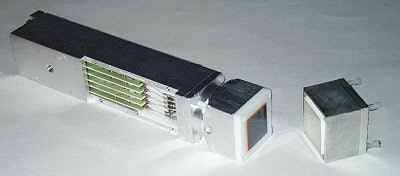
By Juan Jose Vaquero, Ph.D.
Academy of Molecular Imaging

Gamma ray detection using crystal scintillators is a two-step process. First, the 511 keV gamma ray, resulting from the positron annihilation, is converted into a group of photons with a wavelength in or close to the visible range. Second, these less energetic photons are detected, and the resulting electrical signal is amplified using a photodetector.
And they're getting better. During the last decade, new advances in PMT technology have produced position-sensitive PMTs (PS-PMTs), which preserve the spatial information about the location of the scintillation occurrence to facilitate the design of higher-performance detector modules. Although modern PMTs are more compact and robust, they are still bulky and mechanically more difficult to handle than a semiconductor-potential equivalent, aside from the fact that they have low optical quantum efficiency and are sensitive to magnetic fields.
Photodiodes are semiconductor devices that produce an electrical current when exposed to light. They also have an intrinsically low efficiency, and here is where avalanche photodiodes (APD) enter the game. These special photodiodes have an internal gain as a result of hole-electron pairs acquiring sufficient energy to generate additional pairs (hence the avalanche) from the incident photons; the energy source is a reversed-bias high-voltage supply. This signal amplification, achieved by cumulative multiplication of charge carriers, can be regarded as the type of avalanche occurring in gas proportional counters.
APD devices have an output with a better signal-to-noise ratio (SNR) than can be obtained with conventional photodiodes, paving the way for their use with scintillators, since ADPs provide enough energy resolution to be used in PET imaging (IEEE Nuclear Science Symposium and Medical Imaging Conference 1998 Conference Record).
APDs also have a fast time response, high sensitivity in the band between UV to near-infrared wavelengths, and low dark current. APDs have already been applied successfully in fiberoptic communications, laser radar and spatial light transmission, biomedical devices, and low-light detection technologies such as the scintillation produced by a gamma ray in crystals.
 |
| Experimental position-sensitive APD module. Photo courtesy of Radiation Monitoring Devices, Watertown, MA. |
APDs are not free of problems. The earliest devices had to be operated at very low temperatures in order to obtain and stabilize the required SNR. They were very sensitive to temperature and the high voltage (HV) applied to the device, and therefore required thermal stabilization and very well regulated HV power supplies for stable operation. The gain across the active area was highly irregular, making APDs almost useless. More recently, however, gain uniformity has been improved in the newer silicon-based devices.
Commercially available APDs vary in performance and packaging, depending on the application. For small-animal PET applications, the array configuration is preferred due to the high packing factor that minimizes the dead area of the detector. Individual APDs have a poor ratio of active to total area, making it difficult to build a continuous surface detector.
Several prototypes (IEEE Transactions on Nuclear Science, 1996, Vol. 43, pp. 1952-1957 and European Journal of Nuclear Medicine, February 2001, Vol. 28, pp. 136-143) were built using APD arrays, demonstrating the viability of this technology. At the same time, new strategies were developed to overcome the resolution limitations imposed by the array physical dimensions and the parallax effect that degrades spatial resolution on small-diameter PET systems (IEEE Nuclear Science Symposium and Medical Imaging Conference 1998 Conference Record). A special type of APD, the large-area APD (LAAPD), facilitates the design of the same type of detectors that have been used on clinical PET scanners.
For example, the quadrant light-sharing approaches, which resolve high-density crystal arrays, use four large-area photodetectors and measure the light distribution of a given scintillation among them (IEEE Transactions on Nuclear Science, 2002, Vol. 49, pp. 1693-1698).
This alternative becomes more attractive when other considerations apart from imaging performance are considered. The relatively low gain of the APD requires low-noise preamplifiers on each device, and when many arrays of APDs are set together to form a detector ring, space and power consumption becomes a problem, and special, integrated and efficient preamps need to be designed (IEEE Nuclear Science Symposium and Medical Imaging Conference 1999 Conference Record).
The latest developments in APDs point toward position-sensitive devices (PSAPDs) following in the footsteps of the PS-PMTs. At first, devices providing position information had to be operated at cryogenic temperatures, and their performance was not good enough for imaging. However, recent developments have demonstrated that PSAPDs are promising devices for PET and other applications (IEEE Transactions on Nuclear Science, 2002, Vol. 49, pp. 1687-1692).
It may be too early to venture a guess as to the fate of these devices in PET imaging, but new advances and developments keep arising. It should come as no surprise if we start to see positron tomographs using APDs in the not-too-distant future, either as a second photodetector complementing the information provided by the PMTs, or just by themselves.
By Juan Jose Vaquero, Ph.D.
AuntMinnie.com contributing writer
May 21, 2004
Bibliography
"Avalanche photodiodes in scintillation detection for high resolution PET," M. Kapusta, M. Moszynski et al., IEEE Nuclear Science Symposium and Medical Imaging Conference 1998 Conference Record
"Characteristics and use of SiAPD (Avalanche Photodiode), Technical Information SD-28," Hamamatsu, August 2001
"An APD-based quad scintillator detector modules with pulse shape discrimination coding for PET," R. Lecomte, A. Saoudi et al., IEEE Nuclear Science Symposium and Medical Imaging Conference 1998 Conference Record
"An LSO BLOCK detector for PET using an avalanche photodiode array," M.E. Casey, H. Dautet et al., IEEE Nuclear Science Symposium and Medical Imaging Conference 1998 Conference Record
"Investigation of Depth-Of-Interaction by pulse shape discrimination in multicrystal detectors read out by avalanche photodiodes," A. Saoudi, C. Pepin et al., IEEE Nuclear Science Symposium and Medical Imaging Conference 1998 Conference Record
"A power efficient, low noise, wideband, integrated CMOS preamplifier for LSO/APD PET systems," D.M. Binkley, B.S. Puckett et al., IEEE Nuclear Science Symposium and Medical Imaging Conference 1999 Conference Record
Related Reading
PET usage surges in 2002, August 5, 2003
PET procedures surge 70%, April 23, 2003
PET/CT growth sparks gains in U.S. PET market, April 15, 2003
New tracers, technologies propel clinical applications in PET, June 14, 2002
Pioneers reflect on history, future of FDG-PET, April 16, 2002
Copyright © 2004 Academy of Molecular Imaging




















